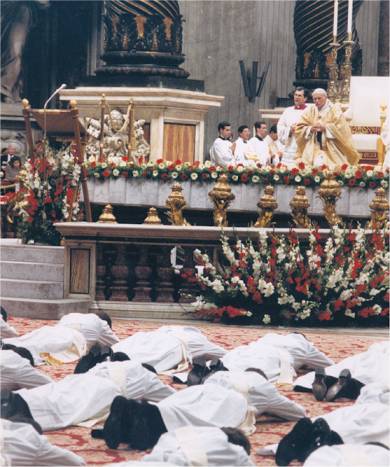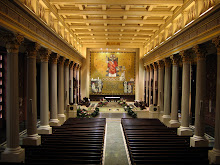Monday, June 29, 2009
For those keeping track at home...
Why did Archbishops Elect Lucas (Omaha) and Aymond (New Orleans) get pallia today, but Archbishop Schnurr here in Cincinnati did not? He is an archbishop, too, no?
Answer, as I see it:
A diocese only has one Ordinary, with full juridical authority, at a time. (Auxiliary bishops have authority that is deputed to them by the Ordinary (main) bishop.) When a successor is named to a diocese, the current office holder is no longer the Ordinary, but is placed as administrator until his replacement is in the Chair, so to speak. The newly appointed 'elect' bishop does take some authority, at least I think so.
In the case of a Co-adjutor Archbishop, such as we currently have here in Cincinnati, he does not have the full authority yet until his predecessor either retires or dies, for a Co-adjutor is technically an auxiliary, even if he has the title of Archbishop, as is the case here.
Archbishop Schnurr will receive the pallium when he becomes the Ordinary of the Archdiocese of Cincinnati.
On a somewhat related note, I saw somewhere about Joseph Ratzinger/Pope Benedict's on again, off again relationship with a pallium. He had it when he was Archbishop of Munich/Freising, lost it when he was named to the CDF, and got it again (?) when he became Dean of the College of Cardinals, which comes with appointment as Cardinal Deacon of the Suburbicarian Diocese of Ostia in Rome. Of course, he has it now as the Holy Father. (These details are a bit sketchier, especially the details about which Cardinals have or do not have the pallium. I think they have to be territorial Archbishops to have it, yes?)
Thursday, June 25, 2009
Trivia Time, Answered
It is the main altar of the Basilica of St. Francis Xavier in Dyersville, Iowa, just west of Dubuque.
A truly gorgeous church in the middle of seemingly nowhere, more pics can be found here.
Catching up on details....
Yesterday was a day of fun in the sun with some of our seminarians and newly ordained priests at Indian Lake, in the northern part of the Archdiocese. While I didn't get out behind the boat to ski, a few of the guys did. But the sunburn on the back of the neck is really aggravated by the collar!
More applications are coming through and the line-up of new men for the Fall continues to hover in the 10-12 range, please pray for all these men.
Hmmm.... a week away from the office and way too many phone calls to return. Yikes!
Monday, June 22, 2009
With you I am a priest.
Trivia Time

Clue #3: a little further west from Notre Dame
Clue #4: 'if you build it, they will come.'
Wednesday, June 17, 2009
congratulations are in order
Congrats and prayers.
Tuesday, June 16, 2009
Unleavened Bread for the Eucharist
First, see Rich’s post ‘Follow me to Panera,’ especially Fr. Fox’s response down the way, both of them.
I wanted to weigh in on why the Latin Rite Church uses Unleavened Bread, versus the Leavened Bread (as it looks, but is not necessarily the case, in the photo the Rich posts). For my source material, I’ve been listening to Dr. Brant Pitre’s discussion of The Bible and the Mass, 22 CD’s at 80 minutes each, and well worth it, too!
First thing to mention, is that Jesus (as we just heard in last Sunday’s Gospel), conducts the New Passover during the Old Passover, specifically on the Feast of Unleavened Bread. This is the first of the Spring Feasts in Ancient Judaism, and connected with this feast is the Feast of First Fruits, when the first offerings of the field would be offered to God. This was the offering of the purest gifts to God, as Abel sacrificed and offered to God way back in the Old Testament. Happening from 15-22 on the month of Nisan, it was always connected with Passover.
But why unleavened bread? In the ancient Jewish sources, leaven was unclean, less than the pure bread which was unleavened. Leaven is yeast, which consumes the sugars of the bread and produces gas as a waste product. Unleavened bread is pure in that it is only bread and water that has been baked. Hence, this was a sacrifice that was pure, connected with the spotless lamb that was sacrificed for Passover. As the first offerings that man was to give back to God were the best of his offerings, not the leftovers.
Interestingly, the bread sacrifice that was made on the feast of Pentecost or Weeks (7 weeks later) was of leavened bread. Here, God accepts a sacrifice that is less than pure, he accepts that which we offer, even our own sinful selves.
I admit, I had never thought of it in this way, but it draws a great parallel: Jesus is the Firstfruits of the Resurrection, and since he is the new Spotless Lamb, he uses unleavened bread for his Sacrifice. At Pentecost, the birthday of the Church, leavened bread is used for the new growth in the Church which contains sinful members, but since they offer themselves to God now, He will accept. Look for the nuance, even though I may not be stating it clearly enough.
For more, I guess you’ll have to get Dr. Pitre’s CD set, which is available at The Catholic Shop in Madeira…. (shameless plug over). (well, maybe not: he'll be at the Deep in History Conference this year on Pillar and Bulwark)
Monday, June 15, 2009
Year for Priests
By the way, it is the 'Year FOR Priests,' not the 'Year of the Priest.' Prepositions are important!
Saturday, June 13, 2009
Ache
Friday, June 12, 2009
Thursday, June 11, 2009
Zeal for Salvation
In my last column, Melchizedek was upheld as the first model of priesthood in the Scriptures. This initial model was rather short lived, unfortunately. During the Exodus, the Tribe of Levi claimed the priestly responsibilities of the Jewish people. This shift proves pertinent for our ongoing discussion regarding the Year for Priests.
As the People of Israel moved out of Egypt, they were to sacrifice the animals that represented the gods of Egypt: goats, sheep and bulls. This was a time of purification so they could worship the One True God with clean hearts and souls. The purification, however, was long in coming, and as Moses was atop Mt. Sinai in conversation with The One Who Is, his older brother Aaron shaped the Golden Calf for the people to worship. Israel’s constant struggle with Idolatry, the worship of false gods, had finally born fruit; and God’s wrath was ablaze.
We pick up the story in Exodus 32 as Moses returns to the camp to rally “whoever is for the LORD.” The Levites rush to the aid of Moses, who then commissions them: "Thus says the LORD, the God of Israel: Put your sword on your hip, every one of you! Now go up and down the camp, from gate to gate, and slay your own kinsmen, your friends and neighbors!" The Levites carried out the command of Moses, and that day there fell about three thousand of the people. Then Moses said, "Today you have been dedicated to the LORD, for you were against your own sons and kinsmen, to bring a blessing upon yourselves this day." (Ex 32:27-29)
This seems like a very harsh treatment on God’s part against those who sinned, setting up the false dichotomy of this seemingly hard handed approach versus the image of a Loving God as presented in the New Testament.
At this time in history, God was working to purify and cleanse the people of Israel from the lasting effects of several hundred years in Egypt. When it comes to ritual and worship, He demands a purity of heart, as well as a purity of experience. When the leaders of the people, who should have known better, lead the people into sin, there must be an account to pay, and the Levites, with their zeal for serving the Lord before all else, gladly rise to the challenge. Dialogue is not the answer, purity and a quest for the Truth are. For the Levites, living according to God’s plan was more important than living, and such an extreme response might call their kinsmen to repentance.
Therefore, we start to realize that the main opposition that Jesus had against the Levitical priests in his day is that they have fallen from their original zeal in serving the LORD above all else. They placed a desire for prestige among men before the desire to serve God.
This initial zeal for the salvation of souls as exhibited by the Levites is what caused them to be selected and consecrated to serve the LORD exclusively. It is this same zeal for the salvation of souls which must be a constitutive aspect of the character of men studying for the priesthood today. The men in formation must put the desire for serving God above the desire for prestige and honor; for even though these come to the priest by virtue of his office, the question he will be asked upon his final judgment will more likely be along the line of: “How many souls did you save?”
This orientation towards salvation of souls is one that can be difficult to achieve, for Jesus promises that as He has been persecuted, so will those who follow Him. Yet, we all work to build a place in the Kingdom of Heaven. Let us all model and imitate the zeal of the Levites in striving for purity of heart in worship, and if the LORD is calling you to spend your life for the salvation of your brothers and sisters, visit www.cincinnativocations.org.
These are supposed to run at Catholic Exchange and on NCDVD.org as well, but I haven't seen them there, yet.
Monday, June 8, 2009
Cincinnati Ordination Video
Sunday, June 7, 2009
Anniversaries, Celebrations and a Rogue Cardinal
Thursday, June 4, 2009
So they must all think...
Catholic Telegraph Vocation Issue
I'm highlighted in two articles:
Use of Technology as Vocation Tool
Andrew Dinners Launched in Archdiocese









